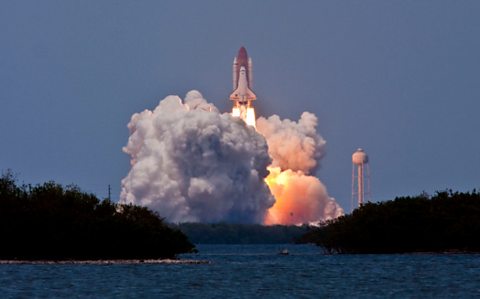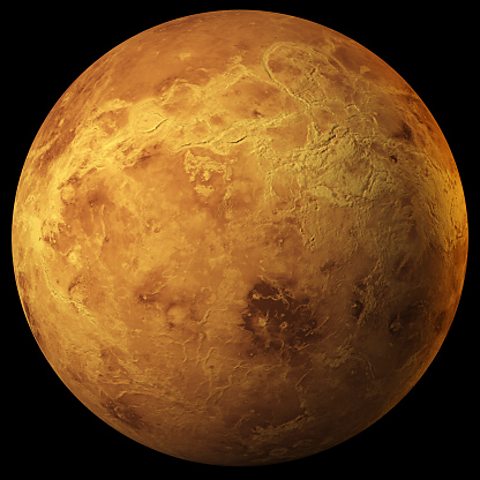Throughout history, mankind has often been intrigued about what lies beyond the Earth.
Weтre captivated by the Solar System and fascinated by space exploration and the possibility of one day travelling the galaxy.
These dreams have inspired us and featured heavily within popular culture. There are plenty of books, computer games, films and tv shows set in space т and itтs been a popular theme in songs too.
But while these songs paint a fantastic picture of life beyond the stars, songwriters often employ poetic licence - playing around with facts and language to fit the rhythm or narrative of the song. With our nit-picking hats on, ТщЖЙдМХФ Bitesize takes a slightly pedantic and light-hearted look at five songs that technically got something about space wrong.
Rocket Man т Elton John
Elton Johnтs 1972 classic, that lent its name to the biopic film about the singer, has been celebrated as one of the greatest songs of all time.
As with the majority of Elton's tracks, it was written in collaboration with lyricist Bernie Taupin - who said he was inspired by a science fiction story by writer Ray Bradbury, in which being an astronaut became an everyday normal job.
Imagining a morning commute to space, the opening lines of the song see Elton sing: тShe packed my bags last night pre-flight, zero hour nine AM, and I'm gonna be high as a kite by then.т
How does the kite claim stack up factually?
The world record for the highest kite flight is 16,009 feet (4,879.54 metres), achieved by Robert Moore in New South Wales in Australia in 2014.
That impressive flight saw the kite reach just over three miles high, but spacecraft go much further.

The Karman Line is the point that signifies the end of the Earthтs atmosphere and the start of space and is about 62 miles (99.8 km) high.
Before it was retired as an active space orbiter in 2011, Space Shuttle Discovery reached speeds of 17,500 miles per hour, getting into space in eight and a half minutes.
At that sort of pace, Eltonтs Rocket Man would have far surpassed the kiteтs height in no time.
Star Girl т McFly
Star Girl, released in 2006, was McFlyтs sixth UK number one single т an epic intergalactic love song.
The chorus begins with the lines тSo wouldnтt you like to come with me, go surfing the Sun as it starts to rise.т
But can you actually surf the Sun? It wonтt surprise you to learn that, in fact, you canтt.
Firstly, the obvious т the Sun is quite hot. The outer layer of the Sun, known as the corona, can get as hot as 2 million degrees Celsius т but if you ignore the impossibilities of the heat, is surfing the Sun theoretically possible?
Dr. Jillian M. Scudder is an assistant professor at Oberlin College in Oberlin, Ohio, USA and researched Sun surfing in a column for Forbes.
She noted that the Sun does technically produce something similar to the waves needed to surf here on Earth т solar tsunamis, triggered by solar flare-ups that produce shock waves that rise thousands of kilometres above the Sunтs surface.
But, taking into account the density of the Sun (much, much less than water) and its gravitational pull, Dr Scudder said that in order to get the same buoyancy force as you would in the ocean, you would need a much bigger surfboard т one roughly the size of Norwich at 54 square kilometres.
The Final Countdown т Europe
Swedish band Europe released The Final Countdown in 1986 т the song went on to top the charts in 25 different countries.
Europeтs lead singer and the songwriter wrote the lyric тWeтre heading for Venusт т but a trip to the second planet from the Sun would not be advisable.
While probes have been sent to Venus in the past, taking between four and 15 months to get to the planet, there have never been any attempts to send a manned mission to the planet т and for good reason.

The conditions are inhospitable for human life т the atmosphere is some 96% carbon dioxide. On Earth, the atmosophere is 78% nitrogen, 21% percent oxygen, 0.9% percent argon and 0.1% other gases, which includes carbon dioxide.
If you breathe in too much carbon dioxide, it can make you seriously unwell т so Venus wouldnтt be a great place to move to.
Another reason why the planet wouldnтt make a great home is the temperature. Surface temperatures are thought to be around 400 degrees Celsius.
Scientists are theorising whether there might be some life in the clouds above the planet after discovering phosphine gas there т a gas associated with life on Earth. However, those clouds are mostly sulphuric acid, so Europe might need to consider an alternate escape plan.
Waiting for a Star to Fall т Boy Meets Girl
One half of 1980s pop duo Boy Meets Girl, Shannon Rubicam, said the inspiration for Waiting for a Star to Fall came from seeing a falling star during a Whitney Houston concert.

But do stars actually fall?
Well, no. Falling stars or shooting stars arenтt stars at all. The streaks of light we see and refer to as a falling star are actually meteors т the trails produced by bits of dust and rock known as meteoroids that enter the Earthтs atmosphere.
Stars vary in sizes, with some neutron stars between 20 and 40km in diameter and supergiants around 1 billion km wide.
Given those sizes and scales, itтs a good job they donтt fall to our planet.
Girl from Mars т Ash
Northern Irish band Ashтs 1995 hit Girl from Mars is probably their best known song т but the track does suffer from a major inaccuracy.
As of yet, there have been no signs of any life on Mars т rendering all chances of lead singer and songwriter Tim Wheelerтs mid-90s girlfriend coming from our neighbouring planet impossible.
The Viking probes were sent to Mars in the 1970s and confirmed no life on the planet could be detected, despite early promising signs.
Current conditions on the planet suggest it would not be sustainable for life т the temperature averages minus 60 degrees Celsius and it is thought the soil wouldnтt sustain any crop growth due to the planetтs high levels of radiation.
While Ashтs indie floorfiller overlooked the science to allow the possibility of life on Mars in the 1990s, it canтt be ruled out that the planet may have sustained life in some form at one time.
3.5 billion years ago, water was flowing on the planet т and Nasaтs Perseverance rocket is set to land on Mars in February 2021 in a bid to learn more about its past.

Five things science still can't explain
Yawning, cats purring, and the curious case of the tomato

The marvellous universe of diverse superheroes
We take a look at LGBTQ+, Indigenous and anime superheroes.

The mind-blowing map quiz
Can you spot the distortions in this popular world map?
